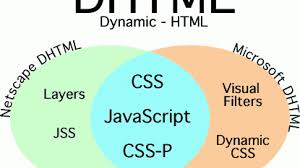Definition of Dynamic HTML in Network Encyclopedia.
What is Dynamic HTML?
Dynamic HTML is a proposed World Wide Web Consortium (W3C) standard developed by Microsoft for creating interactive multimedia Web content.

You can use Dynamic HTML to make Web pages look and behave more like typical desktop applications. Dynamic HTML supports features such as:
- Document Object Model (DOM), a standard whereby every element of a Web page is exposed for scripting. Each element on a Hypertext Markup Language (HTML) page can function as an object that can be modified using scripts and other programs. For example, Dynamic HTML can make the appearance of an object on a Web page change during an onmouseover or onclick event.
- Cascading style sheet (CSS) positioning, which allows HTML content developers to control the style and layout of objects on a Web page using style sheets. These style sheets can then be cascaded to define different levels of precedence.
- Dynamic Content and Dynamic Styles, which HTML content developers can use to dynamically change the content or style of every HTML element on a Web page based on mouse events or other forms of user interaction.
- Data Binding, which integrates data with HTML elements. For example, table rows can be automatically generated from data records and data-bound fields.
Why Use Dynamic HTML?
Dynamic HTML (DHTML) makes a webpage dynamic but Javascript also does, the question arises that what different does DHTML do? So the answer is that DHTML has the ability to change a webpages look, content and style once the document has loaded on our demand without changing or deleting everything already existing on the browser’s webpage. DHTML can change the content of a webpage on demand without the browser having to erase everything else, i.e. being able to alter changes on a webpage even after the document has completely loaded.
Dynamic HTML Advantages:
- Size of the files are compact in compared to other interactional media like Flash or Shockwave, and it downloads faster.
- It is supported by big browser manufacturers like Microsoft and Netscape.
- Highly flexible and easy to make changes.
- Viewer requires no extra plug-ins for browsing through the webpage that uses DHTML, they do not need any extra requirements or special software to view it.
- User time is saved by sending less number of requests to the server. As it is possible to modify and replace elements even after a page is loaded, it is not required to create separate pages for changing styles which in turn saves time in building pages and also reduces the number of requests that are sent to the server.
- It has more advanced functionality than a static HTML. it is capable of holding more content on the web page at the same time.
Dynamic HTML Disadvantages:
- It is not supported by all the browsers. It is supported only by recent browsers such as Netscape 6, IE 5.5, and Opera 5 like browsers.
- Learning of DHTML requires a lot of pre-requisites languages such as HTML, CSS, JS, etc should be known to the designer before starting with DHTML which is a long and time-consuming in itself.
- Implementation of different browsers are different. So if it worked in one browser, it might not necessarily work the same way in another browser.
- Even after being great with functionality, DHTML requires a few tools and utilities that are some expensive. For example, the DHTML text editor, Dreamweaver. Along with it, the improvement cost of transferring from HTML to DHTML makes cost rise much higher.